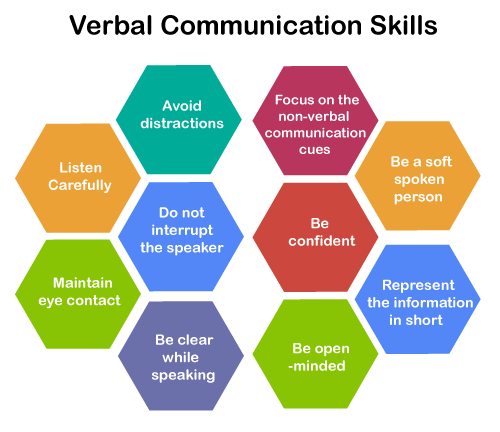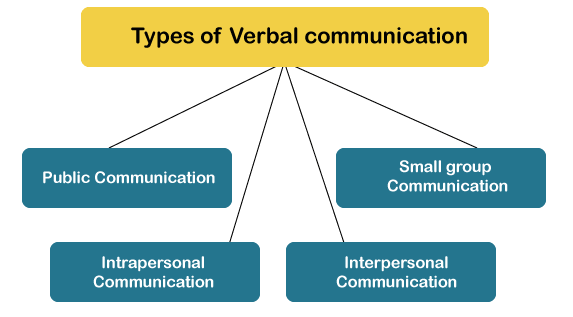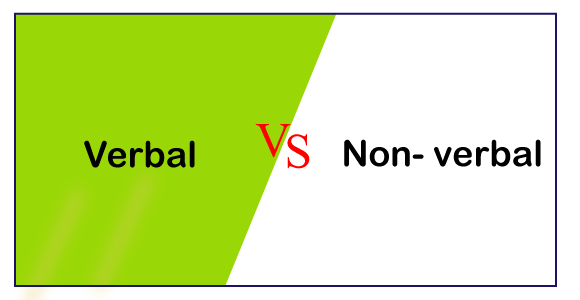Verbal Communication
Verbal communication is defined as communication to express our views, information, and ideas in the form of sound and words. The spoken part usually involves face-to-face communication. Communication through radio, television, or mobile phones is also called verbal communication.
The series of words and grammar rules define the language. Two or more persons can quickly communicate if they are aware of their languages. It might be difficult for people to communicate without a common known language. For effective communication, there must be a common language, which everyone present can understand.
Effective verbal communication encompasses good relations at the workspace and home.
There are two aspects for effective verbal communication; one is 'what to say,' and another is 'how to say.' People good at verbal communication can easily ask some questions or express the information with confidence. They also know how to represent their words so that people can easily listen.
"Written communication also involves the use of words. So, is it a verbal communication?"
Yes, Written communication can also be considered as verbal communication. Reading books, papers, letters, etc. means decoding the views of the author to learn more. Verbal communication is all about the words, which can be spoken or written.
Verbal Communication Skills
Let's discuss the skills required for effective verbal communication, which is listed below:

- Listen carefully
We should be well prepared to listen. We should concentrate on the conversation with the speaker rather than thinking about what we will reply to.
- Maintain eye contact
We should always maintain eye contact with the speaker during the conversation, either in a meeting or personally. The proper eye contact depicts that how much we are interested in his/her thoughts. It is also a sign of appreciation for the speaker.
- Avoid distractions
We should avoid any distractions during the communication, such as checking mobile phones, people passing nearby, opening and closing doors, etc.
If there is a lot of noise, we can suggest moving to another place for communication.
- Do not interrupt the speaker.
We should not interrupt the speaker in between the conversation. It seems like disrespect for the speaker.
- Be clear while speaking.
Sometimes, we require emotional energy to understand what another person wants to say. Always try to be clear while speaking and listening.
- Focus on the non-verbal communication cues
Verbal communication is communication using spoken words. But, it also focuses on how we represent the information. Our facial expressions, body language, eye contact, etc. reflects our way of talking. Hence, non-verbal cues should not be avoided.
- Be confident
We should always be confident while speaking. Do not think what others will say. Confidence depicts our abilities and importance to ourselves. The voice tone, body language, and awareness reflect our confidence during the discussion.
- Be open-minded
We should avoid making judgments or comments about the speaker. Everyone has its perspective, so we should respect the views and thoughts of others.
- Be a soft-spoken person.
The people who talk politely with a smile on their face are more likeable. It makes the conversation more effective also adds enjoyment to their lives.
- Represent the information in short
We should not add paragraphs or stories to our discussion. It makes the listener bored, and he/she may get distracted. We should try to represent our ideas and information as short as we can. It makes our communication more clear and interested.
Types of Verbal Communication
There are four types of verbal communication, which are listed below:

Public Communication
The public communication is defined as the communication of a person with the public. It involves a massive assembly of people. For example, the Prime Minister addressing the public about the multiple developing projects; Other examples include elections, campaigns, public speeches, etc.
Small-Group Communication
The small group communication is defined as communication within two or more people. The number of people participating in such communication is enough to have a good interaction with each other; For example, school meetings, board meetings, press conferences, office meetings, team meetings, family gatherings, etc.
Sometimes, such conversations can become chaotic due to some issues being discussed.
Intrapersonal Communication
Intrapersonal communication is communication within us. It is also called as internal communication. It includes self-thinking, analysis, thoughts, assessments, etc. associated with the inner state of mind.
The person's internal thoughts or feelings play a vital role in intrapersonal communication. It also includes various activities, such as solo speaking, solo writing, solo dancing, concentration, and self-awareness.
Interpersonal Communication
Interpersonal communication is the communication between us and others over the channel. The communication can be online, face-to-face, video conference on mobile, etc.
Interpersonal skills are essential, whether we are a manager, employee, or looking for work. Such skills are also known as soft skills that determine how well a person can communicate, behave, and relate to others.
Tips to enhance verbal communication skills
We can easily enhance our verbal communication skills. So, let's discuss some tips.
- Keep changing the voice tone.
The same tone during communication makes the communication process bored. We should try to vary the voice tone according to the words or feelings. It helps to keep the audience engaged in our discussion.
- Do not forget to think from the perspective of the audience
Good knowledge about the topic does not mean that all the audience can understand your point of view. We should first think of ourselves as an audience and understand what we are trying to communicate. The provided information should be clear, precise, with technical knowledge as per the topic.
- Be positive
The positively oriented people are more likeable and have a great stand in front of the audience. We should try to filter the positive things. The positivity in our communications helps us to build strong teams, boosts audience engagement, and many more.
- Think before speaking
Effective verbal communication includes spoken words, but it should not hurt the people around us. Try to organize the information and thoughts in advance. We can take some time to organize our views before speaking. It will filter our mistakes and makes the communication process smoother.
- Have Patience
Having patience signifies that a person can listen and understand the speaker carefully. It helps us to avoid being irritated at any point during communication. It also helps to avoid making selfish decisions.
- Include feedback during the communication
Communication is a two-way process. Giving and receiving during a communication makes it more effective. We can use non-verbal cues to respond to the speaker, such as nodding head, a smile on the face, etc. It shows the value of the thoughts of the speaker.
Verbal vs non-verbal communication

Some of us might be confused about verbal and non-verbal communication. Let's understand the differences between these two communications.
| Category |
Verbal Communication |
Non-verbal Communication |
| Meaning |
It is defined as the exchange of information with the use of words, either spoken or written. |
It is defined as the exchange of information without the use of words. |
| Communication medium |
It uses words, voice, language, and sentences to communicate with others. |
It uses facial expressions, body language, eye movement, etc. to communicate with others. |
| Decoding level |
Verbal communication is easy to understand if we know the words and language. We need to pay attention to the person who is speaking. |
Decoding in non-verbal communication is complicated as compared to verbal communication. We need to pay attention to various factors, such as body language, facial expressions, etc. |
| Awareness |
It includes more awareness because a person needs to think and analyze before speaking. |
It does not require thinking deeply while expressing his/her views non-verbally. |
| Medium |
Verbal communication requires a single medium to communicate. |
Non-verbal communication requires multiple mediums. |
| Examples |
Face-to-face communication, audio or video recordings, loudspeakers, etc |
The communication takes place through hand movements, expressions, eye movement, etc. between two people who can see each other. |
|



 For Videos Join Our Youtube Channel: Join Now
For Videos Join Our Youtube Channel: Join Now










